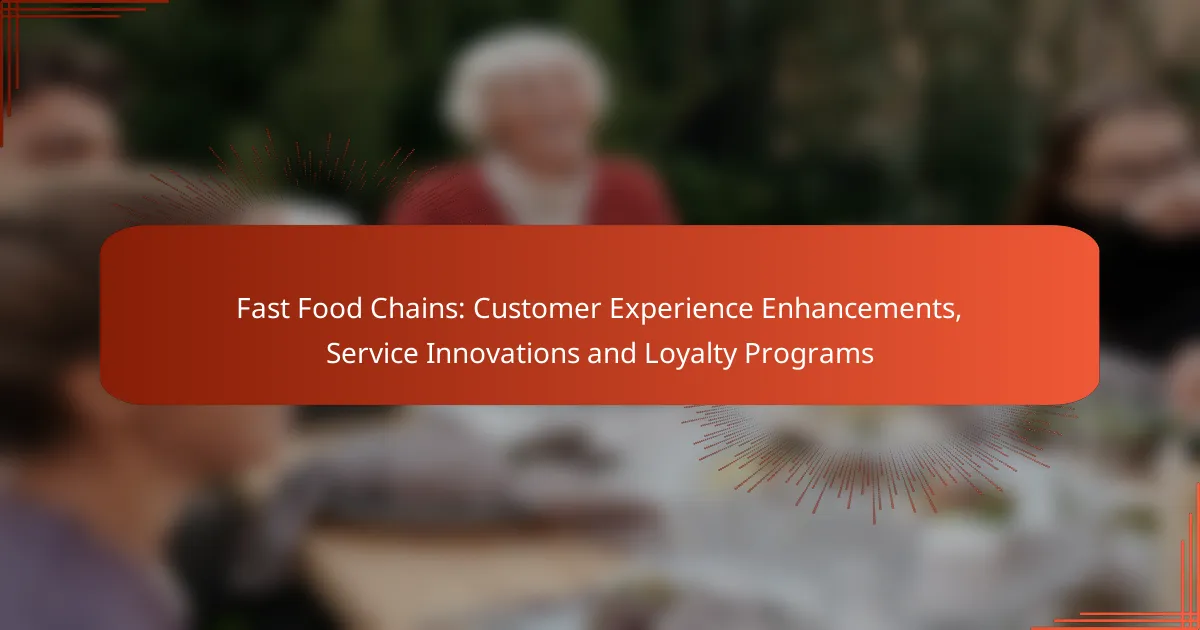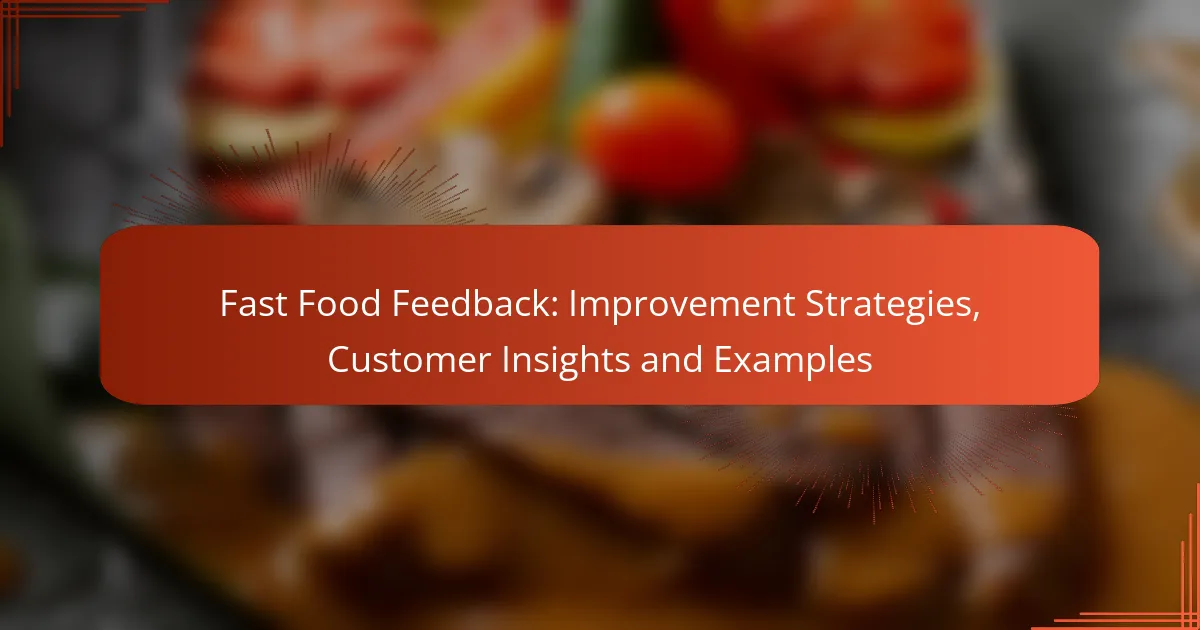Fast food brands are increasingly prioritizing customer experience by adopting strategies centered on personalization, technology, and convenience. By focusing on tailored interactions and efficient service delivery, these brands aim to enhance customer satisfaction. However, the level of customer satisfaction can vary widely, often influenced by factors such as service speed and food quality, with some brands excelling in these areas while others face challenges.

How do fast food brands enhance customer experience?
Fast food brands enhance customer experience by implementing strategies that focus on personalization, technology, and convenience. These approaches aim to meet customer expectations and improve satisfaction through tailored interactions and efficient service delivery.
Personalized marketing strategies
Personalized marketing strategies involve tailoring promotions and communications to individual customer preferences. Fast food brands often use customer data to create targeted offers, such as discounts on favorite menu items or personalized meal suggestions based on past purchases.
For example, loyalty programs can track customer behavior and reward frequent diners with exclusive deals. This not only encourages repeat visits but also fosters a sense of connection between the brand and the customer.
Mobile app engagement
Mobile app engagement is crucial for enhancing customer experience by providing convenience and accessibility. Many fast food brands have developed apps that allow customers to place orders, customize meals, and pay ahead of time, reducing wait times significantly.
Additionally, these apps often feature loyalty rewards and promotional offers, encouraging users to engage regularly. Brands can also send push notifications for special deals, keeping customers informed and engaged with the brand.
In-store technology integration
In-store technology integration enhances the customer experience by streamlining operations and improving service speed. Self-service kiosks allow customers to place orders at their own pace, reducing lines and wait times during peak hours.
Moreover, digital menu boards can display dynamic content, such as nutritional information or limited-time offers, making it easier for customers to make informed choices. Implementing these technologies not only improves efficiency but also creates a modern and engaging dining environment.
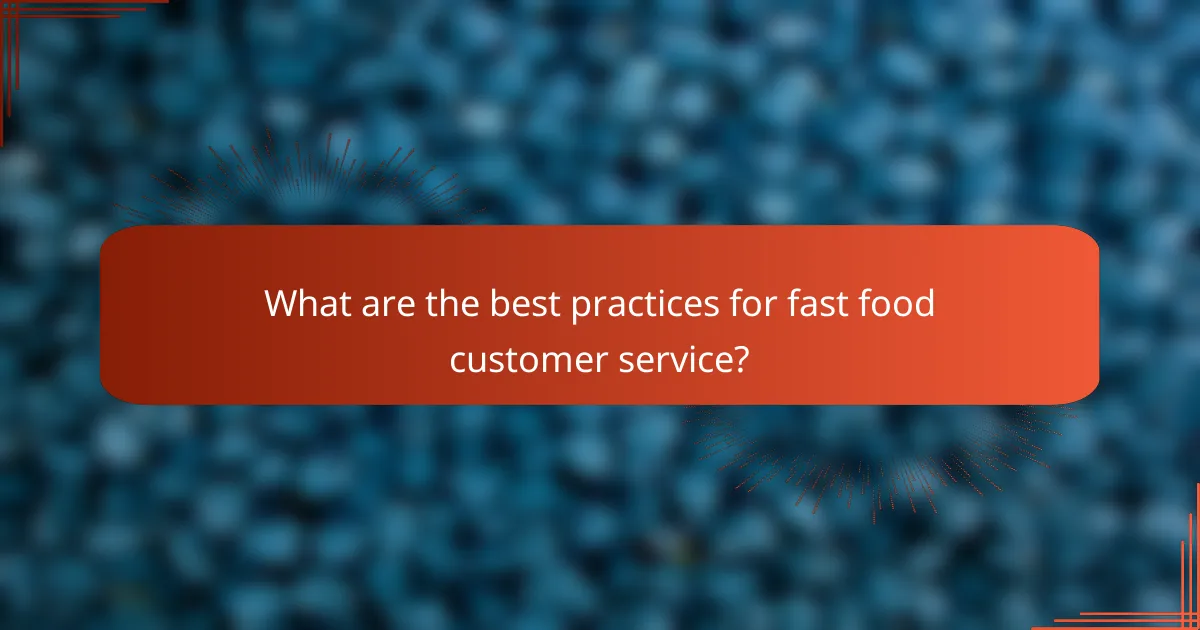
What are the best practices for fast food customer service?
The best practices for fast food customer service focus on efficiency, consistency, and customer satisfaction. Implementing effective staff training and actively collecting customer feedback are crucial for enhancing the overall experience.
Staff training programs
Effective staff training programs are essential for delivering high-quality customer service in fast food establishments. Training should cover not only food preparation and safety but also customer interaction skills, ensuring employees can handle various situations with professionalism.
Consider implementing role-playing scenarios during training sessions to simulate real-life customer interactions. This approach helps staff practice their responses and improve their problem-solving skills, leading to a more positive experience for customers.
Feedback collection methods
Collecting feedback from customers is vital for understanding their experiences and identifying areas for improvement. Fast food brands can utilize various methods, such as surveys, comment cards, and digital feedback platforms, to gather insights efficiently.
Encouraging customers to share their thoughts immediately after their meal can yield the most accurate feedback. Offering small incentives, like discounts on future purchases, can also motivate customers to participate in feedback initiatives, enhancing engagement and loyalty.
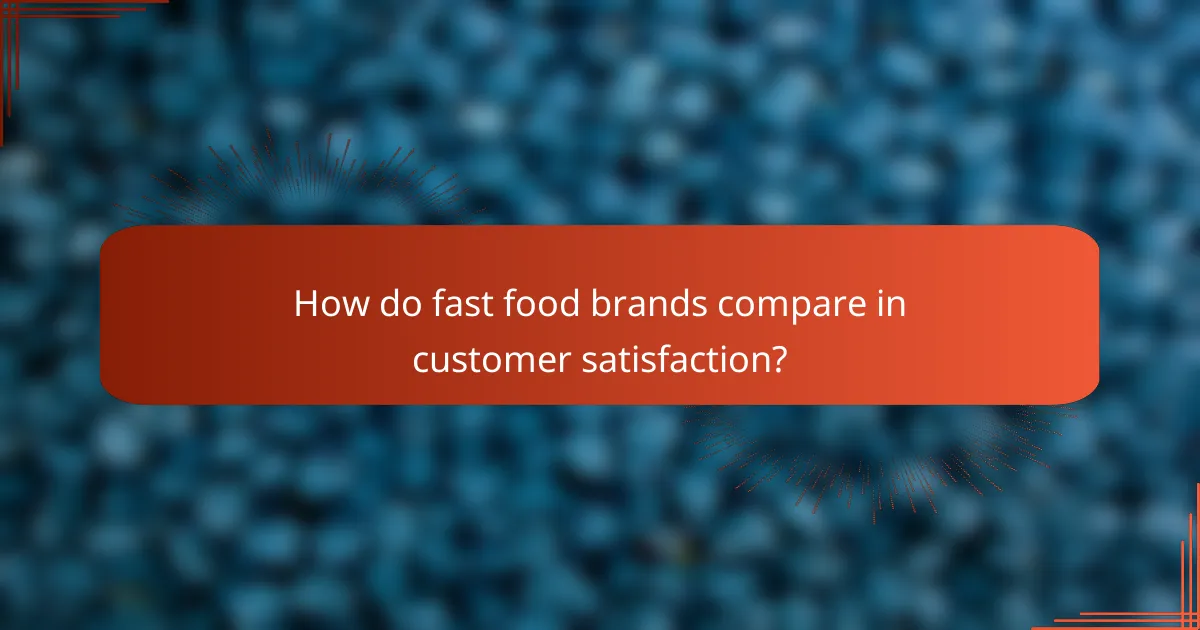
How do fast food brands compare in customer satisfaction?
Fast food brands vary significantly in customer satisfaction, often influenced by service speed, food quality, and overall dining experience. Brands like Chick-fil-A consistently rank high due to exceptional service, while others may struggle with wait times and order accuracy.
McDonald’s vs. Burger King
McDonald’s generally leads in customer satisfaction, particularly due to its extensive menu variety and consistent quality. Customers appreciate the efficiency of their drive-thru service, often averaging around two to three minutes during peak hours.
In contrast, Burger King tends to receive mixed reviews, with some customers praising their flame-grilled burgers while others report longer wait times. The brand’s focus on customization can enhance satisfaction but may also lead to delays, especially during busy periods.
Chick-fil-A vs. Wendy’s
Chick-fil-A is renowned for its customer service, often scoring at the top of satisfaction surveys. Their staff training emphasizes friendliness and efficiency, contributing to a positive dining experience that keeps customers returning.
Wendy’s, while popular for its fresh ingredients and innovative menu items, often faces challenges with service speed. Customers may experience longer wait times, particularly during lunch hours, which can impact overall satisfaction despite the quality of food offered.

What role does digital ordering play in customer experience?
Digital ordering significantly enhances customer experience by providing convenience, speed, and personalization. It allows customers to place orders through apps or websites, reducing wait times and minimizing errors associated with verbal communication.
Impact on order accuracy
Digital ordering systems improve order accuracy by minimizing human error during the ordering process. Customers can review their selections before finalizing, which helps catch mistakes that might occur in traditional ordering methods.
Additionally, many fast food brands implement confirmation screens that summarize the order, ensuring that customers have the opportunity to make corrections. This clarity can lead to higher customer satisfaction and fewer complaints.
Speed of service improvements
Digital ordering streamlines the service process, allowing for quicker order preparation and delivery. Customers can place their orders in advance, which reduces the time spent waiting in line at the restaurant.
Many fast food chains have reported that digital orders can be processed in a fraction of the time compared to traditional methods, often within single-digit minutes. This efficiency not only enhances customer satisfaction but also increases the overall throughput of the restaurant.

How do fast food loyalty programs affect customer retention?
Fast food loyalty programs significantly enhance customer retention by incentivizing repeat purchases through rewards and exclusive offers. These programs create a sense of belonging and value, encouraging customers to choose a brand consistently over competitors.
Starbucks Rewards effectiveness
Starbucks Rewards is highly effective in retaining customers by offering points for every purchase, which can be redeemed for free drinks and food items. Members also receive personalized offers and early access to new products, fostering a deeper connection with the brand.
The program’s tiered structure motivates customers to reach higher levels for better rewards, increasing their frequency of visits. For example, customers can earn stars that lead to free items, which can significantly boost customer loyalty over time.
Domino’s Piece of the Pie Rewards
Domino’s Piece of the Pie Rewards program allows customers to earn points for every order, which can be redeemed for free pizzas. This straightforward approach appeals to customers who appreciate clear and tangible rewards for their loyalty.
Members receive a free pizza after accumulating a certain number of points, typically after every 10 orders. This simplicity encourages repeat business and helps Domino’s maintain a loyal customer base, especially among pizza enthusiasts.
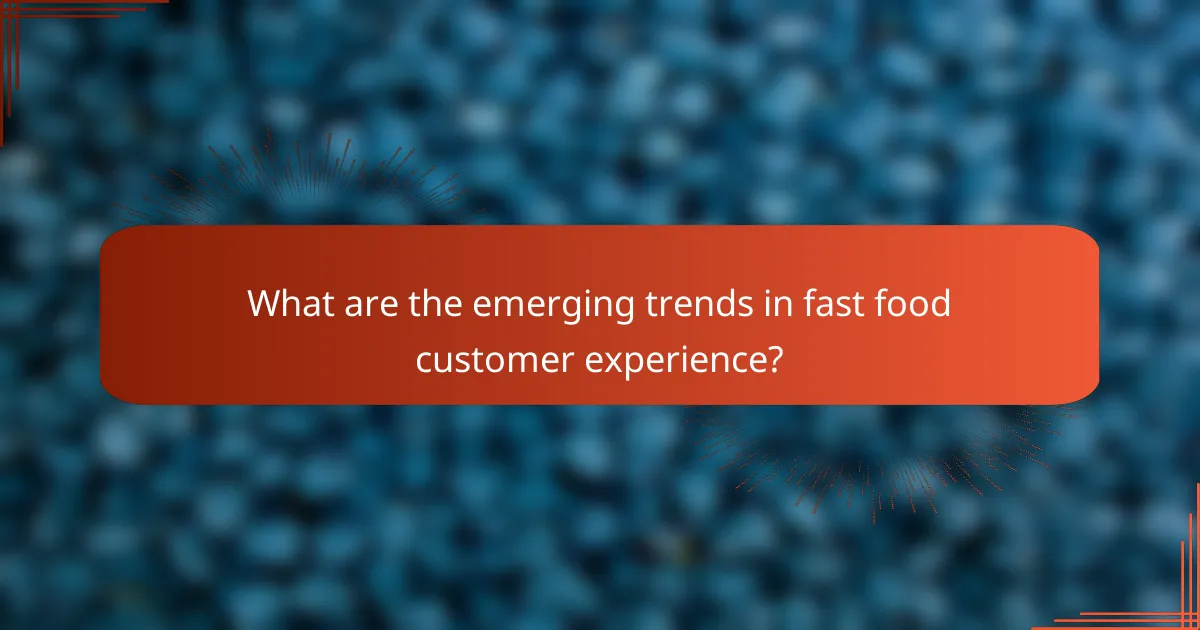
What are the emerging trends in fast food customer experience?
Emerging trends in fast food customer experience focus on enhancing convenience, personalization, and sustainability. Brands are increasingly leveraging technology and innovative practices to meet evolving consumer expectations and preferences.
AI-driven customer interactions
AI-driven customer interactions are transforming how fast food brands engage with their customers. Through chatbots and virtual assistants, companies can provide quick responses to inquiries, streamline ordering processes, and personalize recommendations based on customer preferences.
For instance, some chains use AI to analyze customer data and predict popular menu items, allowing for tailored promotions. This not only improves customer satisfaction but also increases sales through targeted marketing strategies.
Sustainability initiatives
Sustainability initiatives are becoming a critical aspect of customer experience in the fast food industry. Brands are adopting eco-friendly practices such as reducing plastic usage, sourcing ingredients locally, and implementing waste reduction programs to appeal to environmentally conscious consumers.
Examples include offering plant-based menu options and using biodegradable packaging. These efforts resonate with customers who prioritize sustainability, potentially increasing brand loyalty and attracting new clientele.

How do cultural differences influence fast food strategies?
Cultural differences significantly shape fast food strategies by affecting menu offerings, marketing approaches, and customer service expectations. Brands must adapt to local tastes, preferences, and social norms to succeed in diverse markets.
Menu Adaptation
Fast food brands often modify their menus to cater to local culinary traditions and dietary restrictions. For instance, in India, McDonald’s offers a range of vegetarian options, including the McAloo Tikki burger, to align with the dietary habits of a large portion of the population. Similarly, in Japan, unique items like the Teriyaki Burger appeal to local tastes.
Understanding regional preferences is crucial. Brands should conduct market research to identify popular flavors and ingredients, ensuring their offerings resonate with local customers. This adaptation can lead to increased sales and customer loyalty.
Marketing Strategies
Marketing strategies in fast food must reflect cultural values and communication styles. In the U.S., advertising often emphasizes convenience and speed, while in countries like Japan, campaigns may focus on quality and presentation. Local influencers and celebrities are frequently used to enhance brand appeal.
Brands should tailor their promotional messages to align with cultural norms and values. For example, during Ramadan, many fast food chains in Muslim-majority countries promote special iftar menus to attract customers breaking their fast.
Customer Service Expectations
Cultural differences also influence customer service expectations in fast food establishments. In some cultures, customers expect a high level of personal interaction and service, while in others, efficiency and speed may be prioritized. For instance, in the U.S., quick service is often valued, whereas in Mediterranean countries, a more relaxed dining experience may be preferred.
Training staff to understand and meet these expectations is essential. Fast food chains should invest in cultural sensitivity training to ensure employees provide service that aligns with local customs and enhances the overall customer experience.


